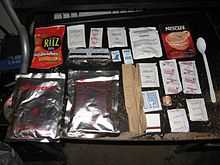Individual Meal Pack

The Individual Meal Pack or IMP is one type of field ration used by the Canadian Forces. The IMP is designed so that a continuous diet provides all the nutrition needed to sustain a soldier in the field. The IMP meets Canada's nutrition requirements, with the exception of calcium and folic acid, which are not significant if the consumption period of rations is less than 30 (consecutive) days.[1]
Requirements
Three IMPs (breakfast, lunch and dinner) provide approximately 3,600 calories (15 MJ), enough to nourish a soldier undergoing strenuous physical activity. The meals are precooked and can therefore be safely consumed either heated or unheated. Under ideal circumstances the entrees are generally consumed heated.
IMP contents

IMPs are divided into six different breakfast, lunch and dinner options.
As of 2005, the following items were available (including all options):[2]
Entrees
- Ham steak with mustard sauce
- Scalloped potatoes and ham
- Sausage and hash browns
- Beans and wieners in tomato sauce
- Breakfast sausages
- Omelette with mushroom sauce
- Gemelli pasta and vegetables in tomato sauce
- Chili con carne
- Beef and vegetable stew
- Rotini with pepperoni and tomato sauce
- Chicken à la king
- Swiss steak with Spanish sauce
- Veal cutlet with mustard sauce
- Meatballs in flavoured sauce
- Indian chicken breast
- Minestrone stew
- Cannelloni with meat and tomato sauce
- Pork chow mein
- Beef Bourguignon
- Meatloaf with onion sauce
- Macaroni and Cheese
Fruits and desserts
- Peaches
- Fruit cocktail
- Pears
- Pineapple tidbits
- Raspberry applesauce
- Strawberry applesauce
- Cherries
- Sliced apples
- Apple sauce
- Blueberries
- Baked maple dessert
Beverages
- Coffee, assorted
- Tea
- Hot chocolate, assorted
- Herbal tea, assorted
- Peach
- Lemon
- Lime
- Orange and pineapple
- Mango
- Strawberry
- Grape
- Watermelon
- Soups
- Cream of mushroom
- Chicken noodle soup
- Cream of tomato soup
- Cream of leek
Miscellaneous
- Crunchy cereals
- Peaches and cream oatmeal
- Raisins and spices oatmeal
- Baked apple oatmeal
- Oriental rice
- Instant plain mashed potatoes
- Mexican rice
- Vegetable rice
- Bread
- Assorted cookies and crackers
- Assorted chocolate bars
- Jam, peanut butter and marmalade
- Instant dressing mix
- Strawberry pudding
- Banana pudding
Condiments (sugar, coffee whitener, ketchup, salt, pepper, towelette, matches, paper towel, toothpick, chewing gum, tabasco) and a spoon are provided in each meal.
Nowadays there are meals available to accommodate Jews, Muslims, Hindus and vegetarians.[3]
Other rations
Other types of rations are used by the Canadian Forces, notably fresh rations, or cooked meals provided directly from the kitchen or by haybox. There are also patrol packs, which are small high-protein snack-type foods (such as beef jerky or shredded cheese) and boxed lunches (consisting of assorted sandwiches, juice, fruit, pasta and a dessert) provided for soldiers to consume in situations in which meal preparation nor the delivery of haybox style fresh rations are not possible, such as travelling for training within Canada or spending the day on a shooting range. The IMP is intended to be issued when fresh rations are not possible, they can also be consumed as emergency rations, unheated.
History
The IMPs appeared in the Canadian Forces in the 1980s, replacing early canned rations (Individual Ration Pack (IRP), Canadian Army Mess Tin Ration, Compo rations). The main menu items of the IMP are "boil in a bag" and require less preparation time and equipment than the previous canned rations.
Preparation and cooking
IMPs are usually "stripped" before field use by removing the cumbersome packaging and discarding extraneous elements the individual soldier does not wish to carry with them. Each bag is contained in a cardboard box, for example, and there are numerous condiment packages which may have no appeal depending on individual tastes.
The new method of heating has greatly improved over the previous options. The soldier simply puts their meal packet into a flameless ration heater. The chemical reaction generates enough heat to ensure a hot meal.[4]
Every meal can be eaten without any cooking; when circumstances permit, the ideal method of preparation is to cook the entrees in a pressure cooker, heated on the standard issue Coleman stove, or by simply boiling the rations in its package in water. Another way to heat up the meal when a stove is unavailable is by putting it in the pocket of a coat during winter. Chemical cooking pouches have also been issued, allowing for flameless meal heating. Other items can also be improved by boiling or adding water, such as packages of soup, rice, powdered drinks and even the prepackaged bread, which is dense and can be softened by exposure to the pressure cooker.
Another technique developed by soldiers in the field is putting the package in the grill covering the exhaust on many armoured vehicles, and on radiators of wheeled vehicles. Some armoured vehicles come with a built in pressure cooker.
See also
- Combat ration
- LRP ration
- United States military ration
- MRE
References
- ↑ MREInfo—Canadian IMP
- ↑ Department of National Defence: “IMP 06 Menu, Questionnaire”, 2005
- ↑ Food ration coverage L'épicerie Radio-Canada(French)
- ↑ Food ration coverage L'épicerie Radio-Canada(French)
External links
- MRE Info website